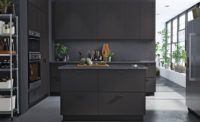Unlike its previous three editions, which were held in Las Vegas, Design and Construction Week headed south for 2017. Literally—to the Orange County Convention Center in Orlando—where from January 10 to 12 more than 2,000 exhibitors and 80,000 attendees convened at the International Builders Show (IBS) and the Kitchen and Bath Industry Show (KBIS). If one conclusion was to be drawn from the two fairs, which showcased thousands of building and construction products, it was this: Smart systems are here to stay, with manufacturers finding ever-increasing residential and commercial uses for them.
Take the model home from the Google-owned Nest Labs. The 784-square-foot structure, located in the convention center’s parking lot, was outfitted with Works with Nest partners—a consortium of companies whose Internet of Things devices may be monitored and adjusted via Nest’s Learning Thermostat and automated software platform. Featured products included August’s Doorbell videocam, Yale’s forthcoming Linus lock, Hunter Douglas’s PowerView motorized shades, and Rheem’s Professional Series tankless and hybrid electric water heaters; all can be operated solo or in concert with Nest technology to save money and increase ease of operation.
The NextBUILD pavilion at IBS moved the automation idea from residential to contract applications. On hand were 75 tech companies offering building and drafting solutions, from Buildertrend and PlanSwift (purveyors of cloud-based construction management software) to Graphisoft and Chief Architect Software (providers of CAD- and virtual reality–powered modeling options). Their mass presence highlighted how from ideation to execution, the building process has shifted from physical to digital.
Over at KBIS, electronic innovations were most evident in the bathroom. Ronbow and Fleurco offered pencil-edge mirrors that emitted an ambient glow and were tricked out with integrated ED lights and USB charging docks; Robern’s AiO collection bested them, though, with units that incorporated touchscreens and Bluetooth speakers. Customized options were rampant, with nearly everything specifiable, down to the color of a pattern and the grain of a surface.
Manufacturers from Geoluxe to Caesarstone presented new materials, including increasingly sophisticated and durable alternatives to natural stone. The former expanded its Pyrolithic Stone options, which are made from a mix of mineral-based materials; the latter launched Transform, a line of superthin scratch, stain, and heat-resistant slabs that can be placed directly atop an existing surface, no demolition required.
The surfaces category also featured beautiful sculptural forms, most notably in concrete. Walker Zanger’s sinewy Liquid Forms tile can be combined into a number of curvilinear compositions. Ann Sacks’s Itai Bar-On collection of poured and cured concrete tiles offers a textural take on the trend with the made-to-order Kwa, which includes a single upturned corner, able to double as a built-in sconce with the simple addition of an LED light.
With technological solutions and embedded digital features vying for attendees’ attention, the occasional nod to Mother Nature was a welcome sight. Kohler’s Real Rain showerhead proved the most successful effort, with its 775 uniquely shaped nozzles releasing water droplets at random to replicate the look and feel of a summer rainstorm. Although the inconsistent stream was simulated, it nonetheless conjured a sense of escape that, even within the buzz of the convention center, momentarily swept you up.










